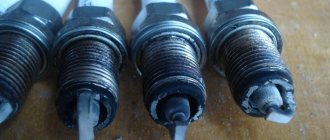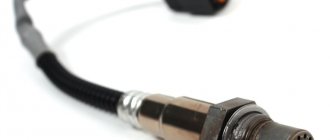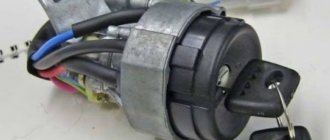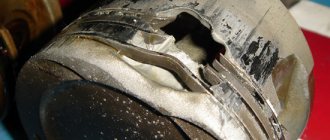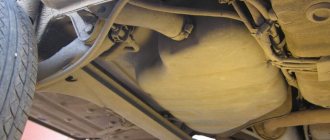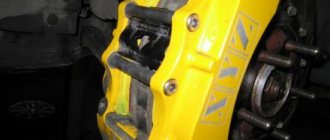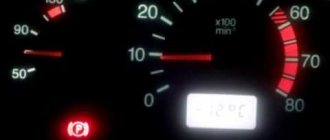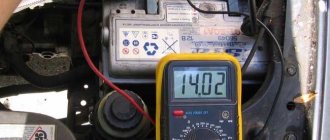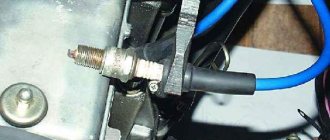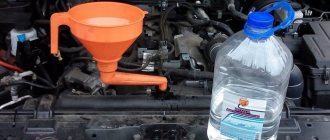How the mechanism works
Almost all tools, both foreign (Husqvarna, Makita, Shtil, Partner 350), and Chinese chainsaws, and domestic (Druzhba, Ural), are designed the same. Therefore, finding the reason why the device does not start and stalls will not be difficult.
There are four elements where problems may arise:
- The fuel for which the carburetor is responsible;
- Lubrication;
- The air that enters through the air filter;
- A spark, the quality of which depends on the ignition unit.
They all depend on each other and interact with each other. If any element does not work correctly, the saw stops working.
Let's start with the fact that all tools start up differently - hot and cold. Two commonly used mechanisms are responsible for this process.
Be sure to look at what is written in the user manual. It states that when turning it on, you need to make sure that the emergency stop brake is engaged. But starting a saw with a brake is much more difficult, so sometimes it’s better not to turn on the brake.
As you can find out from the instructions, inside the body there is a fuel tank and an engine, and outside there is a saw part (bar with chain), a handle and a starter.
First you need to figure out exactly how the tool won’t start. For example, the saw starts up, but immediately stalls, or loses power and cutting quality.
Perhaps interruptions in operation occur due to problems in the engine. But I would not recommend disassembling it right away. It is better to look for the problem from the simplest option.
It is very important to consider the quality of the fuel. If the mixture is prepared incorrectly or has deteriorated over time, then even such reliable tools as the Ural or Husqvarna 145 will not work. The instructions must indicate the proportions and special oil specifically for your chainsaw.
Another common problem is that the user fills the candle during startup. It needs to be inspected; if it is completely dry, then fuel is not passing into the cylinder.
If you see black carbon deposits or a lot of fuel, then the carburetor may not be properly regulating the fuel supply.
If your saw tool starts, but immediately stalls, then the problem needs to be looked for in the carburetor jet or fuel filter. Perhaps they are clogged.
To check if the breather is damaged, you need to disconnect the fuel hose from the carburetor and see if the fuel mixture leaks out of it.
If the saw does not start when hot, then the problem may be in the muffler. Sometimes it gets clogged from the exhaust itself.
Quite often, saw breakdowns occur due to a small amount of chain lubricant. This happens when the channels are clogged or the oil line is leaking.
Also inspect the connections of the pipes with the oil pump fittings to see if they are leaking.
It is very bad when a breakdown occurs in the cylinder. When examining it, you may find unevenness or chips, and this may be the cause of the problem.
Is there fuel in the tank and what is its quality?
Checking the presence of fuel in the tank is the first place to start diagnosing. Even if there is visually still fuel in the tank, make sure that the fuel line is lowered into it. If the fuel in the tank is low, then this is the main reason why it is impossible to start the engine. After adding fuel to the tank, it is necessary to bleed the system, and only after that carry out a test run of the engine.
If there is enough fuel in the tank, make sure that the supply hose inside the tank is not disconnected. On some models of chainsaws, such a malfunction is a “disease”. If the tank is full, this does not mean that the breakdown is not related to the fuel system. Check the quality of the fuel (oil and gasoline). Gasoline for chainsaws is mainly used of the AI-92 grade. As an oil, you need to use only a special two-stroke oil, but not motor oil or even waste oil.
The prepared fuel mixture cannot be stored for more than 2 weeks, as the mixture begins to lose its properties, which negatively affects not only the operation of the engine, but also its starting. How does a poor-quality mixture affect engine starting, you ask? Everything is very simple, when the mixture is stored for a long time, oil precipitates, which leads to clogging of the carburetor channels and jets.
The instructions for each brand of chainsaw indicate recommendations on the ratio of gasoline to oil. This is the recommendation that should be followed when preparing a mixture for a two-stroke chainsaw engine, otherwise it will significantly shorten the service life of your tool.
This is interesting!
You can tell the quality of the fuel by the color of the carbon deposits on the spark plugs.
Restoring the operation of the tool
To restore the operation of the saw, no matter the Ural or Shtil brand, you need to know the location of the breakdown.
First, we check and change the unsuitable fuel mixture. If the saw still does not start, then we check further point by point.
The problem is in the candle - we pull it out and dry it. Under no circumstances should you pierce it, as this will lead to a malfunction of the part. 30 minutes after drying, you can insert the spark plug back, first checking to see if there is any fuel left in its place.
In addition, the spark plug may simply break, so it is better to have a spare one to rule out the cause.
Another reason that the tool does not start well and stalls is poor contact between the spark plug and the high-voltage wire. If everything is in order here, but there is still no spark, the ignition unit itself may be broken. Such a breakdown can only be corrected by replacing it.
Air filters should be checked and cleaned from time to time. If you have not checked it since purchase, it could become clogged with dust and cause a malfunction.
In models such as Shtil 180, Ural or Partner 350, the breather becomes clogged, which often leads to breakdown. To clean it, you can use a sewing needle.
For models Shtil 180, Druzhba, Ural and Husqvarna 142, the muffler sometimes gets clogged, it also needs to be checked and cleaned.
If the problem is in the carburetor, then without appropriate experience you should not try to fix it. It is best to turn to specialists.
If, after checking and eliminating the above problems, your saw still does not start, then most likely the breakdown is hidden in the cylinder group.
When, during inspection, you see damage and chips on the piston or cylinder assemblies, these elements will have to be replaced.
If the cause of a chainsaw malfunction is pipes that are leaking, then most likely there is not enough lubricant supplied to the chain. To fix the problem, just replace the tubes and seal the joints with sealant.
Mechanism parts cannot last forever, so they will have to be changed periodically. To find out how long each part lasts, you need to look at the instructions.
Flushing the carburetor and checking the condition of the jets
If, during the work performed, a stable start is not established, we look for the fault in the carburetor. If you do not have the necessary experience, disassembly should be entrusted to an experienced specialist.
The reason for difficult starting may be, in addition to the previously mentioned air leak:
- contamination of jets;
- water entering the float chamber and depressurization of the float itself;
- loose fit of the float valve that stabilizes the fuel level in the carburetor;
- filling the fuel system with a fuel substitute or expired mixture.
Serious malfunctions that block standard starting, such as air leaks through worn oil seals of the crankshaft shanks, changes in the ignition angle, due to the lack of appropriate tools and technological equipment, are eliminated in repair shops.
Separately about the breakdown of the most common model
Let's look at the problems of Shtil 180 in more detail:
- Clogged carburetor or fuel filter. These are the most common problems that can be easily resolved after cleaning. Sometimes the filter has to be changed;
- Replacing the spark plug;
- Sometimes the cylinder or seals need to be replaced.
The Shtil saw is quite strong and durable, so you can often fix a breakdown yourself. In fact, the same applies to the Partner, Ural, Makita and Husqvarna models.
When we discover a malfunction in our chainsaw, we look for the cause in small ways, gradually checking and eliminating the problems. Such problems are easy to fix yourself. But if the breakdown is serious, and you do not have enough experience, then this should be done by a specialist.
Exhaust duct or muffler cleaning and influence on engine starting
When a chainsaw operates, resinous deposits—carbon deposits—are deposited on the walls of the exhaust channel and muffler. Periodically, this carbon deposits need to be cleaned, but most tool owners remember this only after the chainsaw does not start. Why is this happening? The reason is that the burnt food has nowhere to go, so the engine will not be able to start. When the exhaust channel is contaminated, the chainsaw not only loses power, but also causes the engine to stop working on its own.
Deposits on the walls of the muffler occur due to the following factors:
- Using low-quality gasoline and oil
- Incorrect ratio of gasoline and oil when preparing the mixture
- Long-term use of the tool without preventive measures
There are no difficulties in cleaning a chainsaw muffler. The cleaning sequence is as follows:
- To begin, unscrew the muffler mounting screws.
- The cooling panel with the sealing gasket is dismantled
- Next you need to remove the spark arrester
- The resonator body is disassembled
- All elements are cleaned and washed from carbon deposits with kerosene or other cleaning liquids. This must be done exclusively in a respirator and goggles. Carcinogenic substances are very dangerous for humans
- Wait for the cleaned elements to dry
- Reassemble in the reverse order of removal
When cleaning the walls of the exhaust channel, it is necessary to cover the cylinder hole with a rag. This will eliminate the possibility of dust and sand getting into the cylinder. After cleaning the muffler and exhaust channel of the chainsaw, you can start starting the engine of the tool. At the same time, you will feel how the chainsaw will work at full power.
Finding reasons why a chainsaw won't start
Amateur and professional chainsaws are complex devices. The motor life of their two-stroke engines, components and assemblies has its limitations. For this reason, quite reliable and expensive tools, along with cheap Chinese units, periodically fail and refuse to start. The situation when a chainsaw does not start or stalls is not very pleasant and sometimes confuses the user. How to identify and eliminate the malfunction, restoring the functionality of the tool.
Limitations in independently finishing the warranty instrument
Even with an easy start system, new, untested equipment is relatively difficult to start. It is not recommended to disassemble the recoil starter before the end of the warranty service and repair period.
- For service departments, such a modification may be a reason to refuse free replacement of failed, more valuable equipment.
- If you independently eliminate minor deficiencies, such as “gasoline does not flow” or “the air intake is loose,” penalties are not applied.
- Practice shows that problems with starting budget chainsaws appear after 2-3 years of operation. In such a situation, the owner has to put up with additional repair costs or rely on his own plumbing skills.
Identifying and eliminating obvious chainsaw faults.
To determine the reason why the chainsaw does not start or stalls when starting, it is necessary to troubleshoot the tool. The essence of the procedure is a sequential inspection of the condition and operation of the main working elements of the saw engine. At this stage we check:
- Presence of a spark on the spark plug;
- Fuel supply;
- Filter status;
- Operation of the breather built into the fuel cap of the stalling unit;
- Functioning of the exhaust channel.
Checking the spark on the spark plug and eliminating the causes.
The first step in finding the reasons why a gasoline saw does not start is to check the spark on the spark plug. There are many factors that influence the operation of this element. However, the main ones at the initial stage of tool troubleshooting are:
- Incorrect carburetor adjustment;
- The presence of more than the required amount of oil in gasoline;
- Air filter clogged.
How to change the sprocket?
If you need to replace the sprocket on a Husqvarna 137 chainsaw, you will need to perform the following algorithm:
- Open the side cover giving access to the tire and sprocket.
- After loosening the chain, you need to remove the tire.
- Once the sprocket is free, unscrew the spark plug to gain access to the engine piston.
- You need to rotate the sprocket manually.
- The piston is brought almost to the highest point of the channel.
- The resulting hole must be filled as tightly as possible using a soft candle cord. This will block the movement of the piston.
- To unscrew the sprocket, use an open-end wrench.
The chainsaw won’t start: what to do?
Modern chainsaws are rather capricious devices, although their creators use the same technologies in their production. The problem is the materials used. According to independent sources, a tool for cutting wood in the average price category lasts 500-1200 hours, professional devices - up to 2000, and sometimes longer. At the same time, it is important to follow the manufacturer’s recommendations: maintain the equipment in a timely manner, observe a certain operating mode, fill with high-quality fuel and oil.
Owner reviews and prices
Alexey, 41 years old, Ukhta
I quickly understood the features of the chainsaw, the instructions helped. The tool is of high quality - light and convenient, cuts wood of any density. I've been using it for 3 years - not a single breakdown, only replacement of consumables. They are not difficult to find, they are in every store.
Vladimir, 55 years old, Pskov
Excellent equipment for personal use. Inexpensive, simple and convenient. The high performance of the chainsaw is noteworthy - it cuts quickly and easily passes through knots. To avoid problems, you need to refuel with high-quality gasoline and oil.
Nikolay, 33 years old, Khabarovsk
An irreplaceable item for the garden. I use it for construction, collecting firewood and cultivating trees. The saw is lightweight, reliable, and works equally well in winter and summer. I like the build quality, ergonomics and reliability. There are no problems with maintenance - the parts are inexpensive.
Causes of chainsaw malfunction
If the chainsaw does not start, then you need to carry out step-by-step diagnostics. It is recommended to go from simple to complex and do everything in order. Although devices from different manufacturers differ from each other, they have the same operating principle and layout: they are based on a two-stroke gasoline engine, which rotates a tensioned cutting chain through a gearbox.
Diagnostics must be carried out sequentially:
- Inspection of filters.
- Checking the electrical system (is there a spark at the spark plug electrode or not).
- Inspection of the fuel supply and breather, which is built into the fuel tank cap.
- Study of exhaust gas channels.
Each of the four stages must be considered separately.
What you will need for repair:
- Set of car wrenches, sockets and sockets.
- Screwdrivers: Phillips and slotted, flat spatulas for cleaning parts.
- Metal brush (cord brush) and brushes with hard bristles.
- A basin for washing parts (a cut plastic canister will do).
It is recommended to use a compressor to blow through engine parts. The use of technical gases (especially oxygen) is prohibited.
Filters
Dirty filter on a chainsaw
If the chainsaw has been running for a long time, it is possible that the air or fuel filters may become clogged. In the first case, the required portion of air will not enter the cylinders, and combustion of the fuel mixture will not occur. If the fuel system is clogged, the supply of gasoline mixture will stop.
The air-cleaning element should be removed carefully; dust should not get into the carburetor. The element needs to be blown out, washed with soap and water, dried and then reinstalled.
To check the condition of the fuel filter, you need to remove the hose from the carburetor and try to pump fuel manually. If the stream is too weak or completely absent, the filter needs to be replaced or washed. You can purchase a new one from a dealer, or go to a power tool repair shop.
Checking the spark plug
It may be necessary to install new spark plugs.
The operation is similar to that carried out by all motorists with gasoline engines. If you have a new and 100% working spark plug in stock, then the easiest way is to install it and try to start the chainsaw. The old one should be inspected: heavy carbon deposits indicate that the engine is not working properly. If there are no deposits, the gap between the electrodes may have broken down, causing the spark to stop forming or to be too dim. The distance between the contacts varies between 0.2-0.5 mm.
Why does carbon deposits form:
- Errors made when adjusting the carburetor.
- Added too much oil to the mixture.
- The air filter was clogged.
The verification algorithm is simple:
- Remove the high voltage wire.
- Unscrew the spark plug and attach the previously removed wire back to it.
- Place the spark plug skirt against the unpainted part of the cylinder.
- Try to start the engine.
You can try to disassemble the ignition unit, clean the contacts, dry it, reassemble it and try again. A number of faults cannot be eliminated, so in some cases the unit will require replacement, but this is a last resort.
Gasoline supply. Breather
Breather
One of the most difficult stages of testing.
First you need to prepare your workplace:
- Remove dirt and dust from the workbench.
- Prepare clean rags, brushes, containers for washing small parts.
- If you have a compressor, prepare it to blow through the carburetor channels.
The chainsaw itself needs to be cleaned and blown with compressed air. Now you can start diagnosing.
Check status:
- Fuel tank - there should be no dirt, iron filings, sand or other impurities inside.
- A breather built into the lid - air must enter the tank through it, otherwise a vacuum will be created during operation and fuel will not flow into the carburetor.
- Hoses and tubes - for cracks and other defects. Replace if in any doubt.
After assembly, you need to check: if, as a result of manual pumping with the supply tube removed from the carburetor, the gasoline mixture flows in a dense stream with jerks, then the system is working. If the chainsaw still does not start, then the carburetor is to blame.
Exhaust channels
It may be necessary to clean the exhaust channels on the chainsaw.
After prolonged use, the exhaust channels of the chainsaw may have become coked, causing resistance to the forward movement of the piston. Simply put, gases that are not removed slow down the engine.
How to fix:
- Remove the chainsaw muffler.
- Carefully remove the gasket.
- Remove the spark arrester.
- Disassemble the resonator housing (if possible).
- Clean parts using cleaning solutions (kerosene, WD-40) and mechanically.
- Wipe and dry the knots.
- Put the system back together.
Checking the spark on the spark plug and the gap between the coil and the magneto
The spark plug is the most important part that is responsible for igniting the fuel mixture supplied to the cylinder chamber. If the spark plug has served its purpose, it will produce a weak spark or not produce one at all. You can check this in the following way:
- Unscrew the spark plug
- Place it on the cylinder, connecting it to the candlestick
- Turn on the ignition
- Pull the starter handle
If a spark occurs constantly, then this indicates the serviceability of the spark plug. Moreover, not only the spark plug is in working order, but also the ignition system - the coil and the high-voltage wire. If a spark appears on the spark plug, but intermittently (intermittently), then such a part must be replaced. First you need to check the gap between the contacts. The gap size should be from 0.5 to 1 mm.
For each chainsaw model, manufacturers indicate the recommended gap value, so you need to use a reference book. You can measure the gap with a special feeler gauge or a sheet of paper folded several times.
The absence of a spark on the spark plug indicates a malfunction of the ignition system, so before replacing the part, you should make sure that the ignition coil and high-voltage wire are in good condition.
The chainsaw may not start due to clogged spark plug electrodes. The presence of black carbon deposits on the spark plug or wet electrodes - all this may indicate the following malfunctions:
- Black carbon deposits - the chainsaw carburetor is not adjusted correctly
. The mixture entering the cylinder contains a lot of fuel and little air. The malfunction can be eliminated by cleaning the carbon deposits on the spark plug electrodes and then adjusting the carburetor - If the spark plug is wet (it floods), then this may indicate the following - either the ignition system is faulty (including the spark plug itself), or an excess amount of fuel enters the cylinder, thereby flooding the spark plug.
First you need to make sure that the spark plug gives a good spark, and only then adjust the carburetor. It is not recommended to dry a wet candle using the calcination method, so it should be wiped dry and then allowed to dry in the sun - If the spark plug has red or pink carbon deposits on the electrodes, this indicates that the gasoline used contains a large amount of additives.
Typically, this effect is achieved by gasoline grade AI-95 and higher, an increase in the octane number of which is achieved by adding additives
When the spark plug is brown (brick), this indicates not only that the chainsaw carburetor is correctly adjusted, but also that the ignition system is working properly. If you are using a new spark plug and when tested it produces a weak spark (or no spark at all), this is a sign of a faulty ignition coil. The coil must be replaced along with the high-voltage wire.
This is interesting!
It is necessary to check the size of the gap between the ignition coil and the magnet. Different manufacturers of chainsaws indicate the recommended gap value (usually the value is 0.25 mm); if this value is higher than the norm, then it should be adjusted using a feeler gauge.
How to set up a chainsaw
In the process of repairing Husqvarna chainsaws with their own hands, they identify some malfunctions that appeared as a result of incorrect ignition adjustments and carburetor settings.
The mechanism is responsible for engine speed and is adjusted for operation taking into account the necessary conditions:
- climate:
- height above sea level;
- petrol;
- loads;
- oil used.
By default, for productive work, the factory settings of the carburetor of the Husqvarna chainsaw are set during testing.
The device has 3 customizable areas:
- “L” - low speed jet;
- “X” - high speed jet;
- “T” - idle speed adjustment screw (XX).
The standard settings are:
- "X" = 11/4 turns;
- "L" = 11/4 turns.
To set up the chainsaw, after break-in, adjust the carburetor: first work with the “L” jet, then with the XX “T” and “X” screws. When “L” and “X” are rotated clockwise, the quality of the working air-fuel mixture deteriorates; when rotated counter-clockwise, it becomes richer. Rotating the screw “T” clockwise increases the idle speed.
Carburetor repairs are performed by a specialist.
How to make sure there really is no spark?
To make sure there is a spark on the chainsaw or not, you need to follow a simple procedure:
- The top cover on the case is removed.
- Carefully, with a grip at the very bottom, so as not to tear off the spark plug wire, remove the cap from the spark plug.
- Using the 19 mm socket wrench included in the kit, unscrew the spark plug counterclockwise.
- The cap is put in place, on the candle.
- The thread or nut of the spark plug is “grounded,” that is, pressed against the metal cylinder head.
To ensure reliable contact, the spark plug is pressed against the cylinder using electric pliers, a screwdriver with insulated handles, or a hand wearing dielectric gloves. This should not be done with your bare hand. If the cap is punctured, you can receive a painful shock from a high-voltage discharge (up to 40,000 V at a weak current of up to 80 milliamps).
Place the chainsaw on the ground, press it to the ground with your foot and lightly pull the starter cord. At this time it will be clear whether there is a spark or not.
Causes of a weak spark
A weak spark on a chainsaw is a relative concept. Most often , there is either a spark and the ignition is working properly, or there is none at all . With modern chainsaws with electronic ignition, the spark visually appears weak.
On older models with a mechanical cam breaker, the spark was large and distinctly blue. On modern models with electronics, it is noticeably smaller and paler, often yellowish in color. Therefore, when you need to make sure of its presence, it is better to do it in the shade. In direct sunlight it is almost invisible.
A spark plug malfunction is not uncommon, but chainsaw owners also encounter other malfunctions; read an overview of the most common ones in this article.

